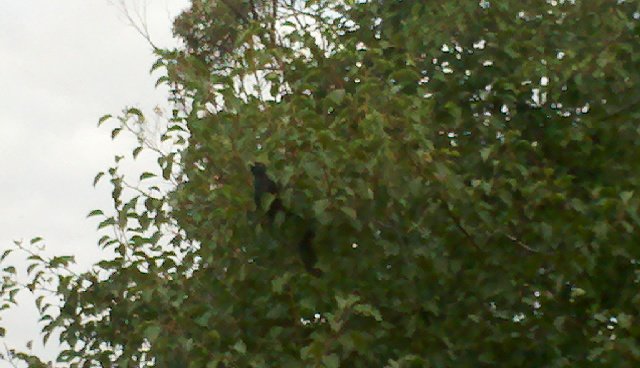G'day,
I am a first time poster. Recently, I became aware of all the different birdsongs/calls/noises around my area, which for some reason(s) did not captured my attention for the past eighteen years.
I am hoping someone can help me identify this mysterious visitor(s) to my backyard. He/she is jet black with a beak that is light amber in colour. His/her eyes are vermillion and quite distinctive due to the contrast with all his/her black feathers. Underneath his/her wings are grey (or sage) in colour.
Apologises for the poor quality photographs. This is the best I can do with my smartphone.
I browse through the 'Bird Finder' in this website (Outstanding website btw), but I am unable to identify my bird.
It is deadset not a raven or crow. I do not think he/she is a Common Blackbird or Spangled Drongo because their birdsongs are completely different from my bird.
I can only think of Eastern Koel, but my bird's call does not match the one recorded by Fred Van Gessel.
Could someone please help?
Cheers!












I will ask before others do, where are you or where was the photo taken?
And by the way welcome!
Dale Huonville, Tasmania
Oh. My bad.
dwatsonbb, the photographs are taken this afternoon in my backyard. I live in Cherrybrook (a suburb in the Hills District of Sydney).
The Magpies and I share a love-hate relationship. I love them and they hate me.
Hi Kook, looking at the shape of the bird and the beak I think it is a male Common Koel. I think it also has a red eye.
M-L
I second that,it looks like a Common Koel
Welcome to the forum, Kook. I'm curious to learn what your bird is but I'm also curious to learn what has occurred to make you curious about the bird sounds in your area after so long. Was it an article you read, a different call that you heard, a lull in your perhaps frantic life that caused you to stop & listen?
Thank you all for the warm welcome and comments!
Araminta and NathanY, I suspected it was a male Common Koel (in fact there were two). However, the calls are deadset different from the one recorded by Fred Van Gessel and this one I found on youtube. Instead of 'a loud ascending whistle or 'koo-el', monotonously repeated' (cited from http://www.birdsinbackyards.net/species/Eudynamys-orientalis), it is more like three whistles in quick succession. I do not know if this is the best way to describe it. The rhythm of the repeated calls are similar to a Spotted Dove at dawn/dusk (I am familiar with Spotted Dove because one particular fella like to call on top of my television antenna), but instead of "cocoo, crooor", the calls of the 'blackbird' are whistles.
Following up on my original question, is it common for two male Eastern Koels (IF they are indeed Common Koels) to be situated in such close proximity? (They were sharing the same tree.) This is taken into consideration that it is their breeding season, hence they are supposed to be competitors.
In regard to your question, Woko, I guess my interest in birds are aroused by moving back to Australia after working overseas in a 'birdless' country for over two and a half years. Previously, I did not realised the birds in my area are so noisy. I guess like most people who live a busy urban life, my mind blocked out and switched off to the insignificant stimulus (like the sound of nature) and focused on 'what's important'. I feel so blessed presently that I am more aware of my surroundings, which I have previously neglected. Nature is truly amazing even when you take a break once in a while just to enjoy all its glory and magnificence. My practice of mindfulness meditation probably also enhance my senses which brought my attention to different bird calls. After that, I became fascinated with different types of birds in my areas including their calls, behaviours and habitats.
There is so much more to learn and this forum (and all the posters) has definitely helped in my enlightenment.
Cheers!
The Magpies and I share a love-hate relationship. I love them and they hate me.
Hi Kook and welcome to the forum
It is definitely a male Eastern or Pacific Koel (depending what list you follow)
3 features distinguish it from the Spangled Drongo - beak colour is ivory and not black, eye colour is red and not orange, tail is long and straight and not medium and slayed
I will attach a pic of each - hope this helps you
Peter
I can identify with much of what you say about being attracted to bird watching, Kook. Thanks for the story.